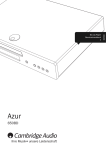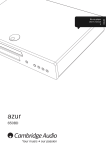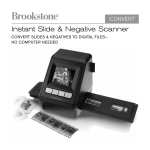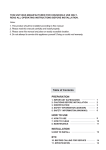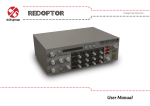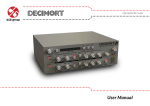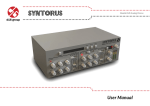Download Cambridge Audio AP26149/1 User's Manual
Transcript
Addendum Playback setup The “Playback Setup” section is designed to configure playback preferences for various contents. The setup items in this section are: Setup Menu 5. Parental Control This is used to set parental control ratings in order to prevent minors from watching inappropriate content. This function does depend on the disc being properly rated and encoded. Press the Enter button to bring up the rating selection menu. To adjust the parental control settings, you must enter the current parental control password. If you have not set a parental control password yet, the default password is “0000”. Playback Setup SACD Priority Multi-Channel Video Setup DVD-Audio Mode DVD-Audio Audio Format Setup Auto Play Mode On The parental control menu contains the following sub-items: Audio Processing PBC On Device Setup Parental Control Network Setup Language BD Ratings - Press the / buttons to select the rating allowed for Blu-ray Discs. “Off” means no ratings control and all discs are allowed to play. Numbers 1 to 21 corresponds to the age limit. Discs encoded with an age limit that is equal to or above the selected age will be allowed, and any rating below the selected age will be blocked. English Exit Configure language preferences Exit MenusSettings SACD Priority................................................. Multi-Channel Stereo CD Mode DVD-Audio Mode.......................................... DVD-Audio DVD-Video Auto Play Mode............................................. On Off PBC................................................................ On Off Parental Control........................................... BD Ratings (default password: “0000”) VD Ratings Area Code Change Password Language...................................................... Player Language Disc Menu Language Audio Language Subtitle Language 1. SACD Priority To select which audio layer to play by default for SACD (Super Audio CD) discs which often have multiple soundtracks. The options are: Multi-Channel – Play the DSD multi-channel surround audio layer. Stereo – Play the 2-channel DSD stereo audio layer. DVD Ratings - Press the / buttons to select the rating to allow for DVD. The available ratings are Kid, G, PG, PG-13, PGR, R, NC17, Adult and Off. The selected rating and below will be allowed, and any rating above will be blocked. If “Off” is selected, all discs are allowed to play. Area Code – Some Blu-ray Discs may have different parental control ratings for different geographical areas. At this time the player only supports the parental control ratings used in the United Kingdom. Change Password – To change the parental control password, enter a 4-digit number as the new password. Enter the new password again to confirm. If the two entries are matching, the new password replaces the old parental control password. 6. Language This is used to configure language preferences: Player Language – To choose the display language for the player’s Setup Menu and onscreen display. Disc Menu Language – To choose the preferred language for displaying DVD and Blu-ray Disc menus. If a disc menu of the selected language is available, that menu will be shown instead of the default disc menu. Audio Language – To choose the preferred audio language for DVD and Blu-ray Discs. If an audio track of the selected language is available on the disc, the Audio track will be played back. Subtitle Language – To choose the preferred subtitle language for DVD. If a subtitle of the selected language is available on the disc, it will be displayed. When “Auto” is selected, the subtitle display is decided by the disc. Note: If your preferred language is not listed in the Audio, Subtitle or Disc Menu options, select “Other” and enter the Language Code found on the later section of this manual. CD Mode – Play the 2 channel PCM CD layer of a hybrid SACD disc. 2. DVD-Audio Mode To select which portion of a DVD-Audio disc to play. The options are: DVD-Audio – Play the DVD-Audio portion of the disc with high-resolution audio. DVD-Video – Play the DVD-Video portion of the disc with Dolby Digital or DTS audio. 3. Auto Play Mode (on/off) To select whether the player willl start playing an audio CD or SACD automatically. When auto play mode is turn on, these discs will start playing upon insertion into the player. When auto play mode is turned off, the player will wait for the user to start playback by pressing the PLAY button. 4. PBC – Play Back Control To enable/disable Play Back Control. Play Back Control is a primitive form of disc menu. The options are: On – If the disc contains Play Back Control, show the menu. Off – Play back the contents by sequence. 1 AP26149/1 azur 650BD The “Video Setup” section of the Setup Menu system allows you to configure various video output options. The menu items in this section are: 1. Picture Adjustment This is used to adjust picture control parameters. The 650BD provides a wide array of picture controls. Please refer to the “Picture Adjustment” section of this manual for details of each control. 2. Primary Output Brightness To select the primary video output method. The options are: HDMI – Use HDMI as the primary video output. This setting will ensure that the HDMI output gets the best possible picture quality. Component and composite video output may not be available or may be limited to a lower resolution based on content source limitations. Color Space Auto MenusSettings Picture Adjustment....................................... Brightness Contrast Hue Saturation Sharpness Primary Output............................................. HDMI Component TV Aspect Ratio............................................ 4:3 Letterbox 4:3 Pan & Scan 16:9 Wide 16:9 Wide/Auto TV System..................................................... PAL (default) NTSC Multi-system Output Resolution........................................ Auto 1080p 1080i 720p 480p/576p 480i/576i Source Direct 1080p24 Output.......................................... Auto On Off (default) Color Space.................................................. Auto RGB Video Level RGB Limited YCbCr 4:4:4 YCbCr 4:4:2 HDMI Deep Color.......................................... 30 Bits 36 Bits Off Display Options............................................ Subtitle Shift OSD Position OSD Mode Normal Silent Remaining Angle Mark On Off PIP Mark On Off SAP Mark On Off Screen Saver On Off Energy Saver Component – Use component video as the primary video output. This setting will ensure that the component output will always be available and displays proper video signals. With this configuration, the video decoder in the player performs any necessary format conversion. Note: Copyright control mechanisms encoded on the disc may limit the output resolution of the component video output. For DVD, if CSS encryption is in use the output resolution is limited to no more than 480p/576p; for Blu-ray Discs, the output resolution is limited to no more than 1080i, and could be lower if the disc contains an Image Constraint Token. 3. TV Aspect Ratio To set the aspect ratio of the player’s output image. The options are : 4:3 Letterbox – Choose this when the display is standard 4:3. A widescreen image is displayed in “letterbox” format with black borders on top and bottom. 4:3 Pan & Scan – Choose this when the display is standard 4:3. A widescreen image will be stretched. 16:9 Wide – Choose this when the display is widescreen 16:9. 16:9 materials will be displayed in its native aspect ratio, and 4:3 materials will be stretched horizontally. 16:9 Wide/Auto – Choose this when the display is widescreen 16:9. 16:9 materials will be displayed in its native aspect ratio, and 4:3 materials will be displayed with black borders on both sides in order to maintain the original 4:3 aspect ratio. 4. TV System To choose the output video standard (PAL/NTSC) to match your TV. The options are: PAL – When playing PAL-encoded discs, no system conversion is performed. NTSC-encoded contents are converted to PAL output. Blu-ray discs encoded with 24Hz frame rate are converted to 50Hz frame rate if neither 1080p24 Output nor Source Direct output resolution is enabled. NTSC – When playing NTSC-encoded discs, no system conversion is performed. PAL encoded contents are converted to NTSC output. Blu-ray discs encoded with 24Hz frame rate are converted to 60Hz frame rate if neither 1080p24 Output nor Source Direct output resolution is enabled. Multi-system – No system conversion is performed. The output video system is the same as that encoded on the disc. Blu-ray discs encoded with 24Hz frame rate are converted to 60Hz frame rate if neither 1080p24 Output nor Source Direct output resolution is enabled. This mode requires a TV that supports both NTSC and PAL systems. Note: Do not select “Multi-system” if your TV does not support both PAL and NTSC systems. The TV display may become a black screen upon inserting a disc encoded in a different system than your TV supports. Should this happen, you can press the OPEN button to eject the disc tray, and then use the Setup Menu to correct the “TV System” setting. 5. Output Resolution To choose the output resolution that best matches your television’s native resolution. For a detailed description on how to choose a proper output resolution, please refer to the “Select the Best Output Resolution” section of this manual. 2 ENGLISH Video setup Addendum 6. 1080p24 Output 9. Display Options This option only applies to the HDMI output at 1080p resolution. Many Blu-ray discs that originated from theatrical movies are encoded using 24Hz frame rate, the same number of frames per second as the original theatrical film. If your TV properly supports 1080p 24Hz, smoother motion can be achieved by enabling 1080p24 output for such discs. The available options are: To configure the options for displaying on-screen information. The following display options are available: Auto – Video encoded in 24Hz frame rate will be output as 1080p 24Hz if the TV informs the player that it can support the 1080p24 signal. On – Video encoded in 24Hz frame rate will be output as 1080p 24Hz without regard to whether the TV can support the 1080p24 signal or not. This is useful if the TV can actually support 1080p24 but does not properly state its capability. Please note that if the TV cannot support 1080p24, selecting this option will result in no video. Off (default) – Video encoded in 24Hz frame rate will be converted to 50Hz (PAL) or 60Hz (NTSC) 7. Colour Space To select the colour space for the HDMI output. The available options are: Auto (Recommended) – The player checks with the display device to automatically determine what colour space to use. If the display device supports YCbCr 4:4:4, then it will be used to avoid extra colour space conversion. RGB Video Level – The HDMI output uses RGB colour space and normal signal range suitable for video displays. Video signal level below reference black or above reference white in the original content is preserved without clipping or alteration. YCbCr 4:4:4 – The HDMI output uses YCbCr 4:4:4 colour space. YCbCr 4:2:2 – The HDMI output uses YCbCr 4:2:2 colour space. Generally this is the colour space that is closest to the colour space encoded on the discs. (All discs are encoded in YCbCr 4:2:0 colour space, and the video decoder decodes it into YCbCr 4:2:2.) 8. HDMI Deep Color To select Deep Colour modes for the HDMI output. Deep Colour is an OPTION for some TVs or projectors that feature HDMI v1.3 or higher input. Normally, each pixel of the video image is transmitted using 24-bit data (8-bit per channel for R, G, B or Y, Cb, Cr). If Deep Colour is supported on your TV each pixel of the video image can be transmitted using 30-bit (10-bit per channel) or 36-bit (12-bit per channel) data. The increased bit depth should result in smoother colour transitions and better gradients for better picture quality. For BD discs with native deep colour on them the extra information will be passed to the TV. For up-scaled content such as DVDs the deep colour output will be interpolated but can still result in a smoother picture. The dithering/limiting options allow discs with deep colour content to be sent to TVs with limited deep colour support. Dithering is a way to softly limit any extra colour information in the source material that the display cannot handle by adding ‘noise’ to prevent an abrupt step in the levels. 30 Bits – Use the 30-bit per pixel Deep Colour mode and hard limit output at 8 bits per colour. 36 Bits – Always use the maximum 36-bit per pixel Deep Colour mode for the output. Off – Do not use Deep Colour, hard limit output at 8 bits per colour. 3 Subtitle Shift – To set the display position for subtitles. When the “Subtitle Shift” is set at 0 (default), subtitles are displayed at the original position as specified on the disc. When it is set at a value between 1 and 5, subtitles are shifted up. When it is set at a value between -1 and -5, subtitles are shifted down. This feature is helpful for instance to customers using a 2.35:1 “Constant Image Height” video projection system. Subtitles can be shifted to the active video area so they do not get cut off. OSD Position – To set the display position for on-screen display (OSD). When the “OSD Position” is set at 0, OSD is shown at the top and bottom of the video screen. When it is set at a value between 1 and 5, OSD is shifted towards the vertical center line of the video screen. Similar to the subtitle shift setting above, the “OSD Position” feature is helpful to customers using a 2.35:1 “Constant Image Height” video projection system. OSD Mode – To select how long the on-screen display information, such as elapsed or remaining time, stays on the TV screen. The available options are: ormal – On-screen display information stays on the TV screen until N the user cancels it. ilent – On-screen display information shows on the TV screen for a few S seconds and then disappears. The front panel display still maintains the selected display information. emaining – On-screen display information stays on the TV screen R until the user cancels it. By default display remaining time instead of elapsed time. Angle Mark (on/off) – To turn on/off the display of an angle mark when a DVD or Blu-ray Disc with multiple available angles is played. Keeping the angle mark off avoids distraction from normal movie watching. PIP Mark (on/off) – To turn on/off the display of a Picture-in-Picture mark when a Blu-ray disc with secondary video is played. Keeping the PIP mark off avoids distraction from normal movie watching. SAP Mark (on/off) – To turn on/off the display of a Secondary Audio Program mark when a Bluray Disc with secondary video and audio is played. Keeping the SAP mark off avoids distraction from normal movie watching. Screen Saver – To turn on/off the screen saver function. The screen saver is designed to minimize burn-in concerns for plasma and CRT display devices. The available options are: n – After about 3 minutes of inactivity, the player will show an O animated Cambridge Audio logo moving on a black background. This allows most areas of the screen to rest and gives all areas an equal opportunity to refresh. Off – The screen saver will not be activated. Use this option if your TV does not have a burn-in issue. nergy Saver – Video output will be turned off after 3 minutes of E inactivity. Many projectors and LCD TVs will go into a standby or sleep mode and turn off their projection lamp or LCD backlight lamp, thus saving energy and prolonging the lamp life. When you press any button on the remote control or the player’s front panel, the screen saver will be cancelled and video output will be restored. If your TV is already in standby or sleep mode, you may need to wake up the TV by pressing a button on its remote or control panel.



